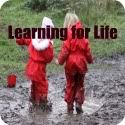During 2012, we had a group of children who really enjoyed becoming involved in what they called ‘real work’. They sought out problems to be solved and set about finding solutions. Their collaborative skills were amazing and frequently left staff in awe of their abilities.
One such work project followed up on some keen observations surrounding a problem with the usage of our water tank. The children noticed that whenever they used the water tank, a large pool of water would form at its base with nowhere to flow. While it was a lot of fun splashing feet through the water, the children also recognised the potential for an engineering challenge.
One morning staff noticed some concentrated activity behind the water tank and wandered over to investigate. ‘We’re digging a river for the water!’‘ the boys explained. ‘What a great idea!’ I said, ‘You’re giving the water somewhere to go’. ‘Yes’, they said, ‘And there is going to be a big lake here!’
The boys had a shared plan that incorporated an understanding of trial and error to bring about success. They regularly tested the effectiveness of their project as they worked. Each child had been alloted a specific role.
The boys did encounter a problem with the water-flow to their lake. The water appeared to quickly soak into the freshly dug soil before it managed to reach the lake. ‘Easy!‘ said the boys as they went about sourcing some PVC piping. ‘See? It works!’ they said.
Then, a bridge was needed to traverse the river.
Now this is where things get a bit challenging for staff. How do you encourage and support such wonderful teamwork and problem solving endeavours while reconciling the issue of the sudden appearance of a water collecting hole in the preschool grounds? For me, this is really a non-issue, BUT our regulatory authority may hold a very different view.
So time to sow a seed for further thought. Staff pondered aloud on the issue. ‘How can we prevent children from tripping over the lake?’ ‘Mmmm, I wonder if mosquitoes might breed in the lakes water?’
Some back and forth discussion between the children and staff, combined with some delicate prompting, brought about a solution that the children could take ownership of. Staff felt that it was important for the children to retained ownership of the project and the decision-making process as a means of fostering their sense of autonomy and feelings of self-worth.
So on the next day, in came the pebbles.
The pebbles seemed to prompt the announcement of a specifically designated playground feature. The area immediately became known as ‘Dinosaurland’.
The dinosaurs arrived, and another issue was raised, ‘Where are the plants? They need plants for food?’
So time to bring in some plants. Not easy on the spur of the moment, but we felt the need to keep the momentum going. The children were very excited and extremely industrious. So we sourced some old tyres from around the grounds, some dirt from a garden bed, and dug up some existing plants that were deemed to be a little over-crowded in their current location.
The children worked together to move wheel-barrow loads of dirt from the garden bed to the tyres.
In went the plants, and the dinosaurs were happy.
Dinosaurland was finally completed after 4 days of highly productive and focused teamwork. The children were extremely proud of what they had achieved and were keen to see their peers enjoy the newly created landscape.
And staff simply felt honoured to be of assistance to the children as they engaged in ‘real work’.




























































